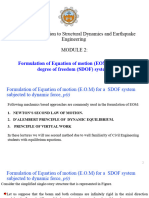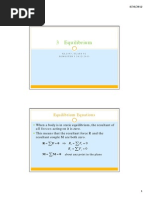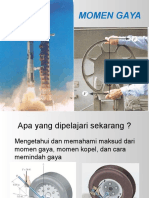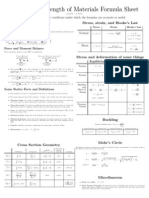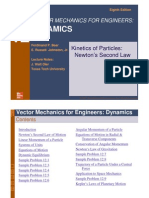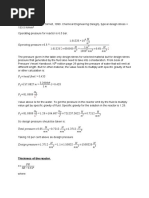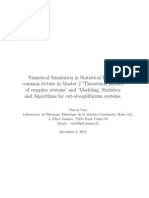ME111 1.1 The Mechanical Design Process: 9/27/00 ME111 Lecture 1 1 9/27/00 ME111 Lecture 1 2
ME111 1.1 The Mechanical Design Process: 9/27/00 ME111 Lecture 1 1 9/27/00 ME111 Lecture 1 2
Uploaded by
Adam NortonCopyright:
Available Formats
ME111 1.1 The Mechanical Design Process: 9/27/00 ME111 Lecture 1 1 9/27/00 ME111 Lecture 1 2
ME111 1.1 The Mechanical Design Process: 9/27/00 ME111 Lecture 1 1 9/27/00 ME111 Lecture 1 2
Uploaded by
Adam NortonOriginal Title
Copyright
Available Formats
Share this document
Did you find this document useful?
Is this content inappropriate?
Copyright:
Available Formats
ME111 1.1 The Mechanical Design Process: 9/27/00 ME111 Lecture 1 1 9/27/00 ME111 Lecture 1 2
ME111 1.1 The Mechanical Design Process: 9/27/00 ME111 Lecture 1 1 9/27/00 ME111 Lecture 1 2
Uploaded by
Adam NortonCopyright:
Available Formats
9/27/00
7.5 10 / 9 12
ME111 Instructor: Peter Pinsky Class #1 September 27, 2000 1.1 The Mechanical Design Process To design is to formulate a plan for the satisfaction of a (human) need
Todays Topics
Identification of need Definition of goal Design is almost always an iterative process Good documentation of analysis is extremely important
The importance of analysis for mechanical design
Synthesis Analysis and optimization
Overview of ME111
Evaluation Detailed design Prototyping and testing
Review of forces, work and power
Focus of ME111
Review of statics: free-body diagrams; internal forces; equilibrium Synthesis Reading Assignment Problem Set #1 Juvinall, Chapters 1 and 2. Puts together the design idea Takes the design idea apart! Idealization (modeling) of elements, supports and loads Determination of critical points for stress and deflections Analysis depends on knowledge of first principles Evaluation Determination of level of safety against all possible failure modes
ME111 Lecture 1 2
Analysis
Due in class 10/4/00 1. 2. Juvinall 2.5 Juvinall 2.7 Juvinall 2.10 Juvinall 2.19
9/27/00
ME111 Lecture 1
9/27/00
9/27/00
1.2 Evaluating Designs The machine or structure must be designed to operate with an adequate factor of safety against failure. Requires knowledge of all possible failure modes and the conditions that will cause them to be active. Examples of common failure modes include:
2.1 Forces We will work with two systems of units: English Engineering Mass Length Time Force Newtons second law lbm ft s lb SI kg m s N
1. Fracture 2. Plastic (non-elastic) deformation 3. Excessive deflection 4. Buckling 6. Fatigue 7. Creep 8. Corrosion 9. Surface failure (e.g., fretting, wear)
F(lb) = m( lbm )
or
a ft s 2 gc
F( N ) = m ( kg ) a m s 2
F(lb) =
m(lbm) a ft s 2 gc
Good design decisions require a good understanding of the behavior of materials For example, the behavior of materials can be divided into two basic types: DUCTILE Stretchy before failure low carbon steel, polymers, skin, rubber, aluminum exhibit slow failure with large deformations
9/27/00
Weight Is the force required to accelerate unit mass in standard earth gravitational field
W ( lb) = m( lbm ) 1 lb = 4.448 N
W ( N ) = m ( kg ) 9.81 1 N = 0.225 lb
BRITTLE Relatively little stretch before sudden failure Cast iron, glass, ceramics, concrete, bone
What is your weight in lb? exhibit fast explosive failure with small deformations
ME111 Lecture 1 3
In N? In N?
What is the weight of a car in lb? Name an object that weights 1 N
9/27/00 ME111 Lecture 1
9/27/00
2.2 Work and Power Force -- displacement Torque -- rotation
3.1 Review of Statics -- Examples Example 1.1 For the frame shown, find (a) all support reactions, and (b) internal forces at point X. C 7.5 ft D X Mid-point A B
W = F S ( ft lb; N m)
W = T ! = T W
! = F V (hp; J ) W
1 hp = 33,000 ft lb / s 1 watt (W ) = N m / s
Example A car transmission has a transmission ratio R=3.0 in first gear
W=1 klb 10 ft 10 ft
Tengine = 3,000 lb in
engine
We know that
Tshaft = ???
shaft engine shaft = engine shaft R
R=
Assuming that power is not lost in the transmission
Tengine engine = Tshaft shaft Tshaft = Tengine
9/27/00
engine = Tengine R = 9,000 lb in shaft
ME111 Lecture 1 5 9/27/00 ME111 Lecture 1 6
9/27/00
Example 1.2 For the truss shown, find (a) all support reactions, and (b) internal forces at point X. Pin connection C D X Mid-point A B 7.5 ft
Example 1.3 Find (a) all support reactions, and (b) internal forces at point X. P = 50 kN 2.5 m
5m
5m
5m
W=1 klb 10 ft 10 ft
9/27/00
ME111 Lecture 1
9/27/00
ME111 Lecture 1
9/27/00
Example 1.4 Find (a) all support reactions, and (b) internal forces at point X.
Example 1.5 Find (a) all support reactions, and (b) internal forces at point X. 2 P P B D
ble ca
X (mid-height)
W P
W P
9/27/00
ME111 Lecture 1
9/27/00
ME111 Lecture 1
10
9/27/00
Mathcad Solution Example 1.6 (bicycle brake lever prototype) 2 P=10 B
Compute tension in cable
6 2 P=10 B
:= atan Given MD=0:
4 6
T := 1
T
T cos ( ) 4 2 10
T := Find( T)
ble ca
T = 6.009 Compute internal forces
D
D A V P M C 3 3 P=10
P := 1 Given Fx=0: Fy=0:
V := 1
M := 1
T cos ( ) P cos ( ) V sin ( ) T sin ( ) P sin ( ) + V cos ( ) T cos ( ) 6 T sin ( ) 6 + M 0
0 0
Compute P, V, M Is the handle bar in tension or compression?
MD=0:
Find( P , V, M ) =
6.009 0 10
ME111 Lecture 1 12
9/27/00
ME111 Lecture 1
11
9/27/00
9/27/00
Example 1.7 30 C 20
3.2 Review of Statics -- Summary of equations Statics in 2-d Resultant of several forces
Rz , M z
z Ry , M y y Rx , M x
x
5 B 5 4 40 3
R = F
Rx = Fx
R = Fx i + Fy j + Fz k
R y = Fy Rz = Fz
Equilibrium of a particle R = F = 0 or
= 0;
= 0;
=0
Principle of transmissibility The conditions of equilibrium or of motion of a rigid body are unchanged if a force acting on the body is moved along its line of action. Thus, forces acting on a rigid body may be treated as sliding vectors. Vector product in 3-d: V = PQ V = PQ sin
i V = Px Qx
In 2-d:
j Py Qy
k Pz = Vx i + V y j + Vz k Qz
Vx = Py Qz PzQ y V y = Pz Qx PxQz Vz = Px Q y PyQx
i V = Px Qx
j Py Qy
k 0 = Vz k 0 Vz = PxQ y PyQ x
9/27/00
ME111 Lecture 1
13
9/27/00
ME111 Lecture 1
14
9/27/00
Moment of a force about a point in three dimensions
M0 = r F M 0 = rF sin = Fd
Varignons theorem The moment about any point of the resultant of several concurrent forces is equal to the sum of the moments of the individual forces about the same point. Couples in 3-d
y M0 r O d z x
F ! Any point on line of F
A couple consists of two parallel forces that are equal in magnitude and opposite in sense. The moment of a couple may be represented by a free vector M = r F M = rF sin = Fd
i M 0 = rx Fx
j ry Fy
k rz = M x i + M y j + M z k Fz
M x = ry Fz rz Fy M y = rz Fx rx Fz M z = rx Fy ry Fx Any point on line of F M F
! Any point on line of F F Any point on line of F
r d
In 2-d: r F d
Equivalent force-couple systems A force may be tranlated parallel to itself to a new point of application provided a couple M 0 = r F is added.
M0 M0 = r F i M 0 = rx Fx
9/27/00
M 0 = rF sin = Fd j k 0 = M 0k 0
ME111 Lecture 1 15 9/27/00
F r
M0 O
ry Fy
M 0 = rx Fy ry Fx
ME111 Lecture 1
16
9/27/00
Equilibrium of a rigid body in 2-d Three equations: R = F = 0
R M0 = M0 = 0
Statics in 3-d Equilibrium of a rigid body in 3-d Six equations: R = F = 0 M = M0 = 0
R 0
=0
0
=0
=0
=0
=0
=0
Mx = 0
M y = 0
Mz = 0
Moment of a force about a point in three dimensions O y M0 r O
C
Alternative sets of equations:
F ! Any point on line of F x d
F
F
=0
=0
A
=0
A
=0
B
A = any point in x-y plane AB not parallel to y-axis A, B, and C not on straight line z
=0
B
=0 =0
=0
=0
Equilibrium of a two-force body The two forces must be equal in magnitude, opposite in direction, and lie along same line. Equilibrium of a rigid body in 3-d Six equations: R = F = 0
R M0 = M0 = 0
Equilibrium of a three-force body The three forces must lie in same plane and be either concurrent or parallel.
M0 = r F M 0 = rF sin = Fd M x = M0 i = ry Fy rx Fx
i M0 = rx Fx
j ry Fy
k rz = M x i + M y j + M z k Fz
rz = ry Fz rz Fy = Cross ( ry , rz , Fy , Fz ) Fz rz Fz = rz Fz rx Fx = rz Fx rx Fz = Cross ( rz , rx , Fz , Fx )
F M
x
=0
F M
y
=0
F M
z
=0
M y = M0 j = M z = M0 k =
17 9/27/00
=0
=0
=0
rx Fx
ry = rx Fy ry Fx = Cross ( rx , ry , Fx , Fy ) Fy
ME111 Lecture 1 18
9/27/00
ME111 Lecture 1
You might also like
- Chapter 11 and 13 HomeworkDocument31 pagesChapter 11 and 13 HomeworkFatboy91100% (18)
- CVE 253 Course OutlineDocument53 pagesCVE 253 Course OutlineSamuelShinaAyodeleNo ratings yet
- Variable Notes & Comments: Extended Base Dimension SystemDocument16 pagesVariable Notes & Comments: Extended Base Dimension SystemthimmarayaswamymNo ratings yet
- Statics Chapter 4Document11 pagesStatics Chapter 4aniceto labianNo ratings yet
- Coplanar Non Concurrent Force SystemsDocument23 pagesCoplanar Non Concurrent Force SystemsLester MarquezNo ratings yet
- Statics Chapter 4Document34 pagesStatics Chapter 4Paulo MontesNo ratings yet
- TFU3013 General Physics I: RevisionDocument82 pagesTFU3013 General Physics I: Revisionerdayu86No ratings yet
- Course Format: Sean Dalton WWW - Itsligo.ie/staff/sdaltonDocument33 pagesCourse Format: Sean Dalton WWW - Itsligo.ie/staff/sdaltonUC ProductionNo ratings yet
- 1 T 2Document16 pages1 T 2Mr. Sambath LimNo ratings yet
- Mekanika Teknik PDFDocument141 pagesMekanika Teknik PDFAnonymous dSFbLxc9No ratings yet
- Lesson 2 Resultant of Force SystemDocument26 pagesLesson 2 Resultant of Force SystemRainiel MontalbaNo ratings yet
- Module 2 - Fall 2023Document38 pagesModule 2 - Fall 2023Muhammad FahimNo ratings yet
- Review Chapter 4-5Document29 pagesReview Chapter 4-5fannyparamitaNo ratings yet
- Moment and CouplesDocument66 pagesMoment and CouplesUnknown_unknown_unknownNo ratings yet
- Moments: Academic Resource CenterDocument10 pagesMoments: Academic Resource Centerhardhik 199No ratings yet
- Coplanar & Non Coplanar Force Systems PDFDocument23 pagesCoplanar & Non Coplanar Force Systems PDFMohammed Sumer50% (2)
- L05 - EquilibriumDocument25 pagesL05 - EquilibriumHassanAhmed124No ratings yet
- Statics Ch2 - Present - 4 (3D Moment and Couple)Document21 pagesStatics Ch2 - Present - 4 (3D Moment and Couple)Alexander LibakNo ratings yet
- Chapter 12 Static Equilibrium Elasticity: 12.1 The Rigid Object in EquilibriumDocument5 pagesChapter 12 Static Equilibrium Elasticity: 12.1 The Rigid Object in EquilibriumJhonny Zuasnabar PaucarNo ratings yet
- 03 EquilibriumDocument15 pages03 EquilibriumAndy BayuNo ratings yet
- Kinetics of ParticlesDocument21 pagesKinetics of ParticlesKhen Villanueva100% (1)
- Chapter 3 Rigid BodyDocument21 pagesChapter 3 Rigid BodyimfendiNo ratings yet
- Strength of MaterialDocument12 pagesStrength of MaterialKrztofer PrnzNo ratings yet
- Forces and EquilibriumDocument57 pagesForces and EquilibriumUnknown_unknown_unknownNo ratings yet
- 3 Kuliah Momen Gaya KopelDocument28 pages3 Kuliah Momen Gaya KopelAverus ZamanNo ratings yet
- Momen Gaya KopelDocument28 pagesMomen Gaya KopelReza Maliki AkbarNo ratings yet
- Chapter 3 Analysis of Pin Jointed FramesDocument19 pagesChapter 3 Analysis of Pin Jointed Framesghodghod123No ratings yet
- Principles of StaticsDocument7 pagesPrinciples of StaticsJommarVocalTagalogNo ratings yet
- Engineering Mechanics Notes FinalDocument4 pagesEngineering Mechanics Notes Finalsonalisarkar23478No ratings yet
- Statics NotesDocument8 pagesStatics NotesRyanCalleja100% (1)
- Engg Mech Chapter 3Document24 pagesEngg Mech Chapter 3Mark John OgagNo ratings yet
- Chapter 4Document35 pagesChapter 4Nur Amira Mardiana ZulkifliNo ratings yet
- Lab Manual - 1Document43 pagesLab Manual - 1Nabeel AhmedNo ratings yet
- ForceDocument45 pagesForcefastidious_5No ratings yet
- الملزمة الرئيسية الفيزياء Document54 pagesالملزمة الرئيسية الفيزياء m4332060No ratings yet
- Strength of MaterialDocument80 pagesStrength of Materialpriyankar007No ratings yet
- Persentasi Momen GayaDocument28 pagesPersentasi Momen Gayayoan04No ratings yet
- Bending Stress in Beams: Basic AssumptionsDocument9 pagesBending Stress in Beams: Basic AssumptionspidotnasirNo ratings yet
- Chapter 3-Moment and CouplesDocument45 pagesChapter 3-Moment and CouplesIsabelNo ratings yet
- Statics ch2 - Present - 4 (3D Moment and Couple) PDFDocument21 pagesStatics ch2 - Present - 4 (3D Moment and Couple) PDFKeith Tanaka MagakaNo ratings yet
- Equilibrium in 3D NewDocument32 pagesEquilibrium in 3D NewTuhafeni HailekaNo ratings yet
- Theory 1Document191 pagesTheory 1Joseph Arben Agus100% (1)
- Mechanics of Solids Week 1 LecturesDocument16 pagesMechanics of Solids Week 1 LecturesFlynn GouldNo ratings yet
- Chapter 5 StaticDocument22 pagesChapter 5 Staticnur aisyahNo ratings yet
- Ejercicios Mecánica ClasicaDocument95 pagesEjercicios Mecánica ClasicaNeiser Cerna Guerrero100% (1)
- Statics and Strength of Materials Formula SheetDocument1 pageStatics and Strength of Materials Formula SheetRichard TsengNo ratings yet
- Dynamics: Vector Mechanics For EngineersDocument38 pagesDynamics: Vector Mechanics For Engineersteo1285No ratings yet
- Beam Reactions and ShearDocument39 pagesBeam Reactions and Shearangelufc99No ratings yet
- Concept QuizDocument55 pagesConcept QuizhaloNo ratings yet
- Quest 7 SolutionsDocument6 pagesQuest 7 SolutionsAdmnUnpwnd100% (2)
- Module 3 MomentDocument48 pagesModule 3 MomentKiel JohnNo ratings yet
- Static Force AnalysisDocument39 pagesStatic Force AnalysisShrikant BhoyarNo ratings yet
- Student Solutions Manual to Accompany Economic Dynamics in Discrete Time, second editionFrom EverandStudent Solutions Manual to Accompany Economic Dynamics in Discrete Time, second editionRating: 4.5 out of 5 stars4.5/5 (2)
- ID-LA-IsO Series Low Cost RFID Reader Module Used Animal Tagging LF ISO11785Document10 pagesID-LA-IsO Series Low Cost RFID Reader Module Used Animal Tagging LF ISO11785AbleIDLtdNo ratings yet
- ME111 5.1 Stress in Three Dimensions: Zy ZZ ZXDocument6 pagesME111 5.1 Stress in Three Dimensions: Zy ZZ ZXAdam NortonNo ratings yet
- Lecture 3Document11 pagesLecture 3Adam NortonNo ratings yet
- D D D I TC: Final ExamDocument5 pagesD D D I TC: Final ExamAdam NortonNo ratings yet
- CH 5 SolDocument20 pagesCH 5 SolAdam NortonNo ratings yet
- PhysRevB 110 035113Document16 pagesPhysRevB 110 035113qq546795070No ratings yet
- Tank Jet MixersDocument2 pagesTank Jet MixersGabriela Axinte100% (1)
- DCA 40181 Environmental ScienceDocument149 pagesDCA 40181 Environmental ScienceShauqi MustafarNo ratings yet
- Diplomawork MarsimoyiTerefeBangoF8EE3C BME 2019Document116 pagesDiplomawork MarsimoyiTerefeBangoF8EE3C BME 2019Milkeessaa TarrafeeNo ratings yet
- Operating Pressure 6.5 × N M N M × MM N MMDocument8 pagesOperating Pressure 6.5 × N M N M × MM N MMAZMINo ratings yet
- J Ijhydene 2019 05 176Document10 pagesJ Ijhydene 2019 05 176John TorrezNo ratings yet
- Madelung Constant - WikipediaDocument22 pagesMadelung Constant - WikipediaSatyajit biswas100% (1)
- 14 Analysis of Vertical Load Bearing Capacity of A Single PileDocument12 pages14 Analysis of Vertical Load Bearing Capacity of A Single PilejasamnajNo ratings yet
- ScienceDocument84 pagesSciencejhemakshNo ratings yet
- Atomic Physics 12 PagesDocument12 pagesAtomic Physics 12 Pagessadam hussainNo ratings yet
- 2011 Prelim YearlyDocument23 pages2011 Prelim YearlyAndrewHannaNo ratings yet
- Photchem and Photobio C ReviewsDocument20 pagesPhotchem and Photobio C ReviewssarahNo ratings yet
- Monitor TheoryDocument4 pagesMonitor TheoryBustaDrivesNo ratings yet
- Introducción A Los Materiales Cerámicos Capítulos 1,2,3 KingeryDocument68 pagesIntroducción A Los Materiales Cerámicos Capítulos 1,2,3 KingeryLaura BárbaroNo ratings yet
- Photodriven Quantum Teleportation of An Electron Spin State in A Covalent Donor-Acceptor-Radical System (2019)Document6 pagesPhotodriven Quantum Teleportation of An Electron Spin State in A Covalent Donor-Acceptor-Radical System (2019)Louis Peronet VergaraNo ratings yet
- Ballistic PendulumDocument6 pagesBallistic Pendulumume akbar100% (1)
- Richard Feynman-Quantum RealityDocument16 pagesRichard Feynman-Quantum Realitydiego batoaNo ratings yet
- Kuliah NMRDocument92 pagesKuliah NMRDedi saputraNo ratings yet
- Engineering Consultants and Planners, Roorkee, UK.: Circular Raft FoundationDocument5 pagesEngineering Consultants and Planners, Roorkee, UK.: Circular Raft Foundationsamir bendreNo ratings yet
- Materials System SpecificationDocument21 pagesMaterials System Specificationnadeem shaikhNo ratings yet
- Numerical Simulation in Statistical PhysicsDocument201 pagesNumerical Simulation in Statistical PhysicsMasamichi Nogawa100% (1)
- Semihermetic Scroll CompressorsDocument34 pagesSemihermetic Scroll CompressorsAdrian AzcuagaNo ratings yet
- RatesDocument7 pagesRatescwjhgvq964No ratings yet
- Clarke - Smethurst UNSAT 2014Document32 pagesClarke - Smethurst UNSAT 2014anarNo ratings yet
- IOEGC 2019 Summer 046Document8 pagesIOEGC 2019 Summer 046umeshNo ratings yet
- Experiment 6 SolutionsDocument4 pagesExperiment 6 Solutionschristie villaNo ratings yet
- Astm c1678 Standard Practice For Fractographic Ceramics and GlassesDocument16 pagesAstm c1678 Standard Practice For Fractographic Ceramics and GlassesMaria Fernanda Rodriguez TorresNo ratings yet
- Numerical Study of Casson Nanofluid Flow Over A Stretching SurfaceDocument14 pagesNumerical Study of Casson Nanofluid Flow Over A Stretching SurfacePriyanka KilaniyaNo ratings yet
- E060701020025 PDFDocument6 pagesE060701020025 PDFمنير أحمدNo ratings yet
- Wax Deposition of Bombay High CrudeDocument2 pagesWax Deposition of Bombay High CrudeArjit KumarNo ratings yet











